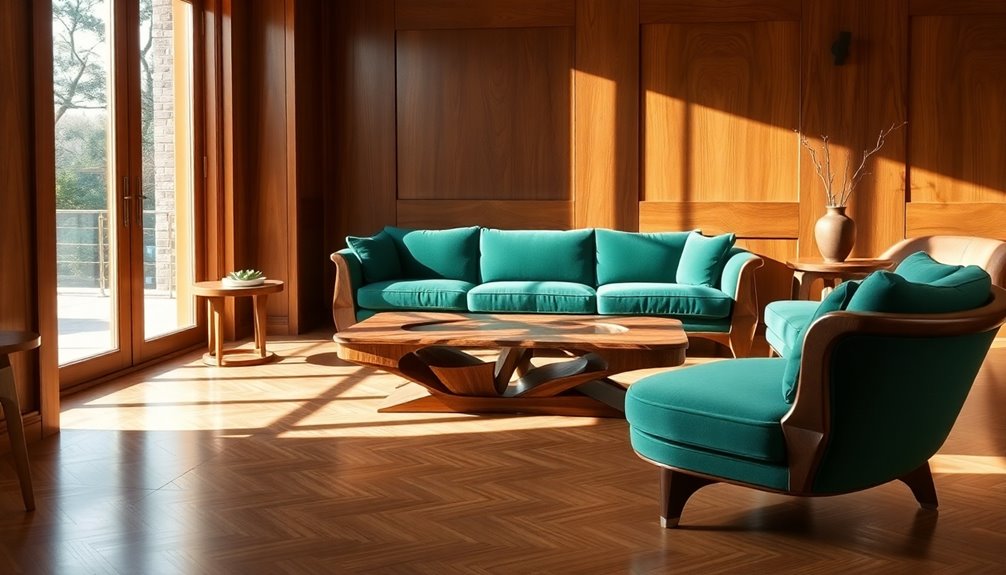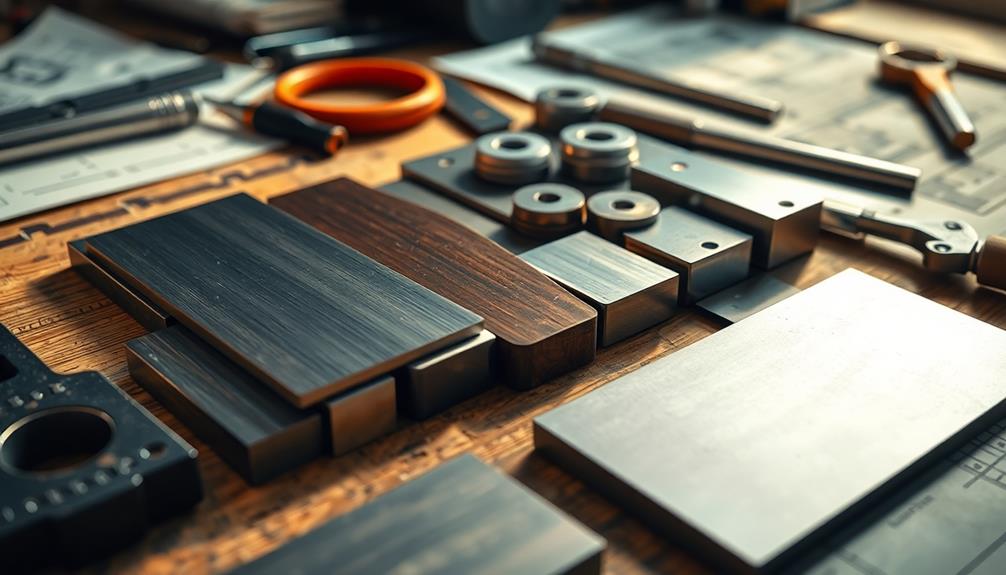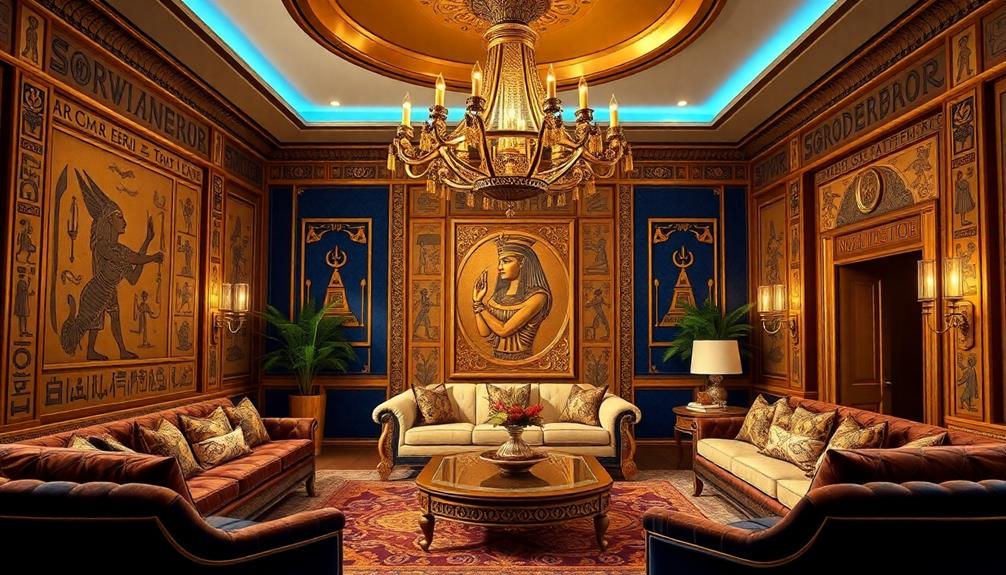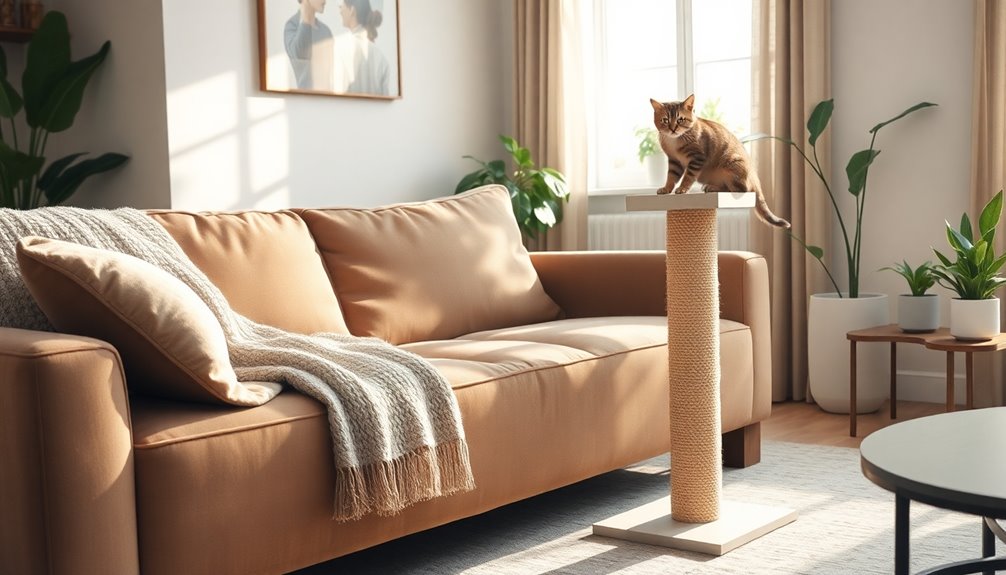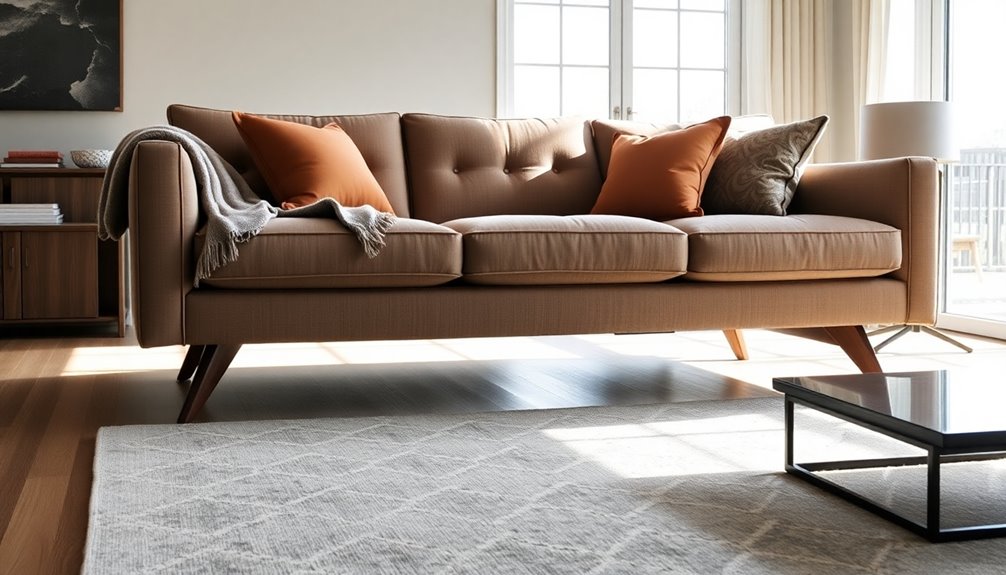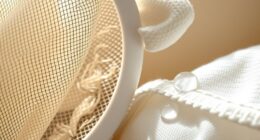Sustainable Art Deco furniture brings together timeless design with eco-friendly materials, perfect for your contemporary home. You'll find pieces crafted from renewable resources like bamboo and reclaimed wood, showcasing unique aesthetics while promoting environmental responsibility. These items often feature bold geometric shapes and luxurious finishes, adding elegance to any space. Plus, many manufacturers prioritize ethical sourcing and fair labor practices. The durability of eco-friendly furniture means it'll last for years, reducing waste. Embracing sustainable design not only enhances your home but also supports local artisans. Explore how you can transform your living space with these stunning pieces.
Key Takeaways
- Sustainable Art Deco furniture combines bold geometric designs with eco-friendly materials like reclaimed wood and bamboo, enhancing contemporary interiors responsibly.
- Utilizing certified materials like FSC and PEFC wood ensures sustainable sourcing and reduces environmental impact while maintaining luxurious aesthetics.
- Upcycled vintage Art Deco pieces can be restored through creative techniques, promoting sustainability while adding unique character to modern homes.
- Eco-friendly finishes and low VOC materials improve indoor air quality, aligning with contemporary preferences for healthier living spaces.
- Supporting local artisans for sustainable furniture fosters community growth and preserves traditional craftsmanship, ensuring ethical production practices.
Eco-Friendly Materials Overview
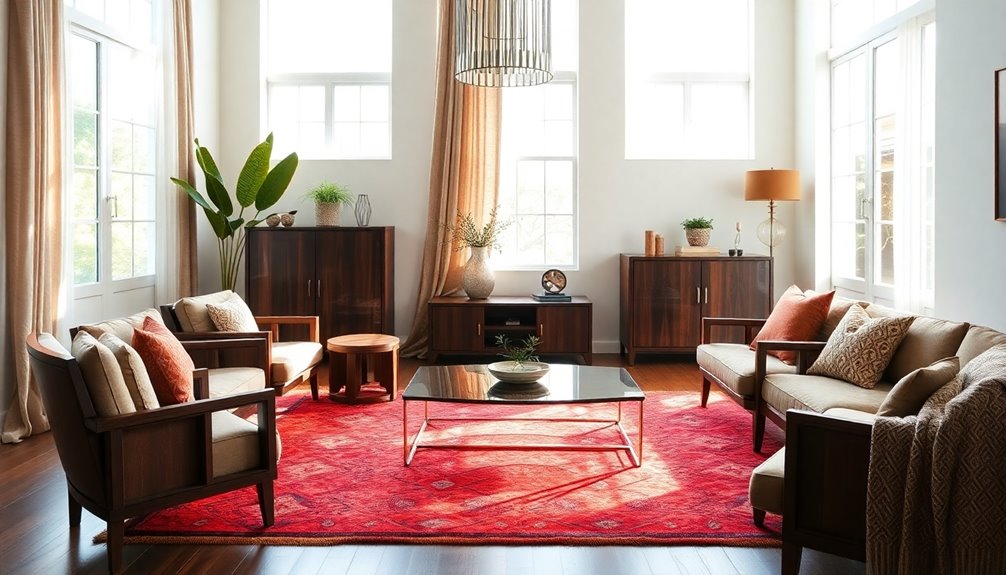
When it comes to sustainable furniture design, eco-friendly materials play a crucial role in creating pieces that are both stylish and responsible. Choosing wood from sustainable sources helps reduce deforestation and supports responsible logging practices. Look for certifications from organizations like the Forest Stewardship Council (FSC) or Programme for the Endorsement of Forest Certification (PEFC) to ensure your wood is sustainably sourced. Reclaimed wood is another excellent option, minimizing waste by repurposing materials from old buildings or discarded furniture.
Bamboo and natural fibers also contribute to sustainability. Bamboo grows quickly and can be harvested without harming the environment, making it a great example of renewable resources. Rattan and cane are renewable materials that require no pesticides, perfect for handwoven furniture. Additionally, using non-combustible materials in furniture design can enhance safety and durability, ensuring long-lasting pieces.
For upholstery, consider natural fabrics like organic cotton or hemp, which are breathable and biodegradable.
Recycled and upcycled materials further promote sustainability. Recycled wood reduces landfill waste and creates new furniture, while recycled metals like aluminum cut down on the need for virgin resources.
Upcycling transforms discarded items into unique pieces, adding character to your home. By selecting these eco-friendly materials, you can enjoy beautiful furniture while being mindful of the planet.
Art Deco Design Characteristics
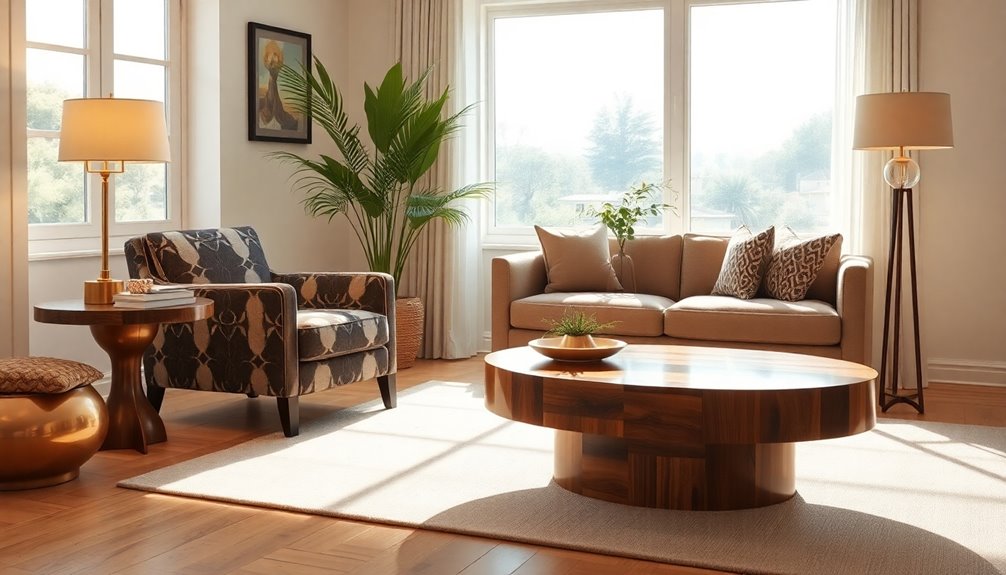
Art Deco design is characterized by its bold geometric shapes, vibrant colors, and luxurious materials that together create a striking aesthetic.
You'll notice the prominent use of geometric forms like triangles, circles, and rectangles, often incorporated into patterns such as chevrons and zigzags. These shapes help establish visual balance and symmetry, with repeated motifs found in architectural elements like doorways and facades.
Symmetry plays a crucial role, ensuring balanced proportions and harmonious compositions throughout your space. This emphasis on symmetry is a defining feature of Art Deco architecture, contributing to its enduring appeal.
You'll see facades adorned with layered shapes and intricate line art, maintaining that essential equilibrium. This attention to symmetry gives Art Deco its distinctive flair.
Luxurious materials are another hallmark of this style.
You might find pieces crafted from ebony, ivory, silk, and marble, paired with metals like brass and chrome for added opulence.
Lavish ornamentation, including intricate carvings and stylized motifs, enhances the visual appeal, often adorned with metallic colors like gold and silver.
Sustainable Production Practices
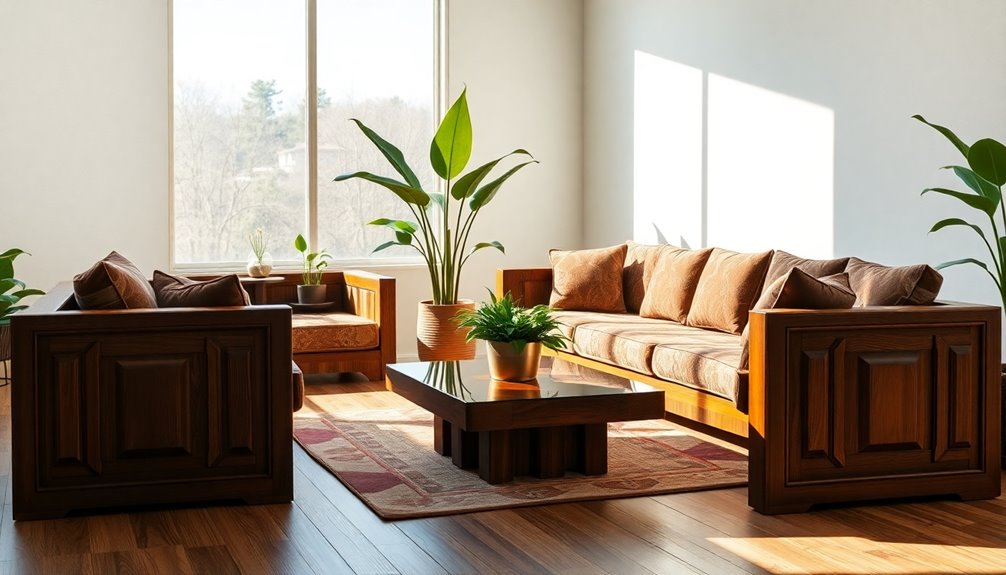
Sustainable production practices play a vital role in the creation of Art Deco furniture that aligns with modern environmental values. When you choose eco-friendly pieces, you'll likely find materials sourced from renewable resources like bamboo, which regenerates in just 3-5 years.
Many manufacturers utilize recycled metals, plastics, and wood to lower demand for virgin resources and minimize waste. Additionally, reclaimed wood from old buildings not only reduces deforestation but also preserves historical materials.
In the manufacturing process, companies prioritize low-VOC finishes and water-based adhesives, cutting down on air pollution associated with traditional methods. By avoiding harmful chemicals, they enhance indoor air quality, creating healthier living spaces for you and your family. Furthermore, this shift to non-toxic processes can reduce indoor air pollutants by up to 90%.
Moreover, innovative design techniques achieve high material utilization rates, sometimes exceeding 95%, while zero-waste policies ensure that production scraps are repurposed effectively.
Many manufacturers harness renewable energy sources, like solar and wind, to power their operations, reducing their carbon footprint significantly. By opting for locally produced furniture, you also contribute to lower transportation-related emissions, supporting both the environment and local economies.
Embracing sustainable production practices means you're investing in a healthier future.
Durability of Eco-Friendly Furniture
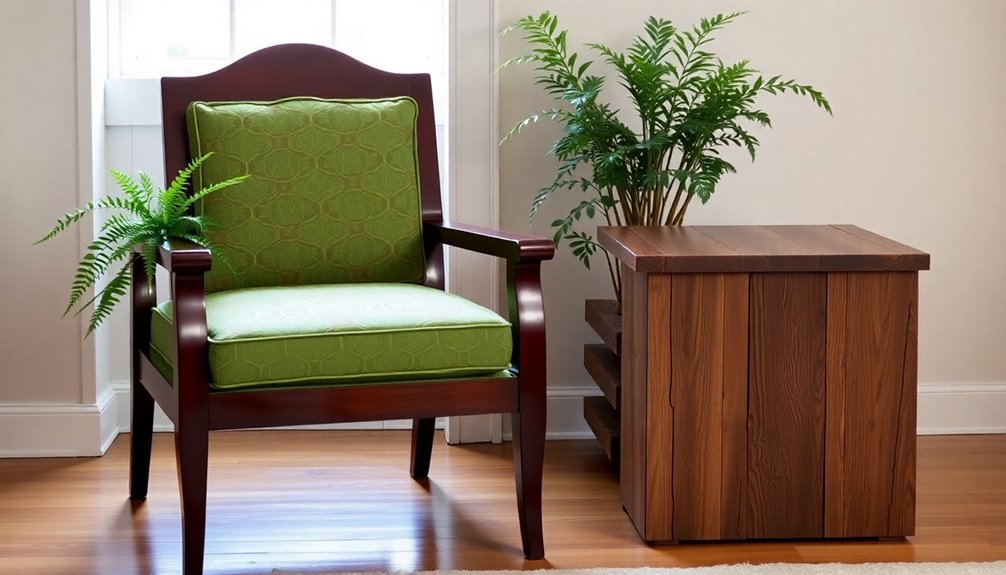
Eco-friendly furniture stands out for its impressive durability and longevity, making it a smart investment for any home. By choosing pieces crafted from high-quality materials, like solid or reclaimed wood, you're opting for furniture that resists termites and rot.
Reclaimed wood, in particular, offers exceptional stability, having already undergone years of expansion and contraction, ensuring it's less likely to warp or crack.
Vintage and eco-friendly furniture often features superior craftsmanship, with sturdy frames built from recycled metals or solid wood. This attention to detail contributes to their longevity.
Plus, using natural finishes and water-based adhesives enhances both durability and healthiness. Additionally, opting for antique furniture significantly lowers your carbon footprint, which reflects a commitment to sustainable living.
Regular maintenance can extend the life of your eco-friendly pieces significantly—up to 15 years—so implementing a care schedule is crucial. Simple tasks like quarterly deep cleaning and annual refinishing can keep your furniture in excellent shape.
In a world increasingly focused on sustainability, investing in eco-friendly furniture means you'll not only enjoy durable, beautiful pieces but also reduce waste and minimize your environmental impact.
Ultimately, this choice supports a greener future for generations to come.
Social Responsibility in Manufacturing
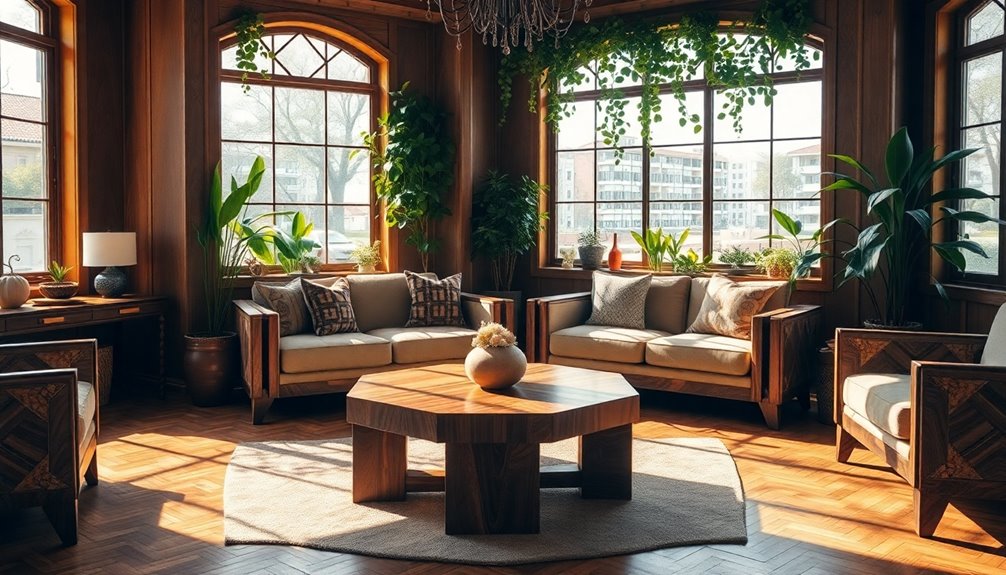
While many consumers focus on the aesthetics of furniture, social responsibility in manufacturing is equally important. When you choose sustainable Art Deco furniture, you're supporting fair labor practices and ethical sourcing.
Manufacturers prioritize safe working conditions, fair wages, and reasonable work hours, ensuring that employees aren't exploited. They often audit suppliers to guarantee compliance with international labor standards, fostering a community of respect and fairness. Additionally, the adoption of eco-friendly alternatives is essential for industry progress, which is similar to how performance exhaust systems improve efficiency in automotive tuning.
Moreover, responsible manufacturers source materials from certified suppliers, like those recognized by the Forest Stewardship Council (FSC). This means the materials respect local populations' rights and avoid contributing to deforestation or social strife.
Many brands also use reclaimed or recycled materials, reducing the demand for virgin resources.
By collaborating with local communities, manufacturers support local economies and promote traditional craftsmanship. This not only strengthens community ties but also minimizes transportation-related environmental impacts.
Regulatory compliance and certifications, such as the Global Organic Textile Standard (GOTS), further ensure that these brands align with global sustainability objectives.
Environmental Benefits of Sustainable Choices
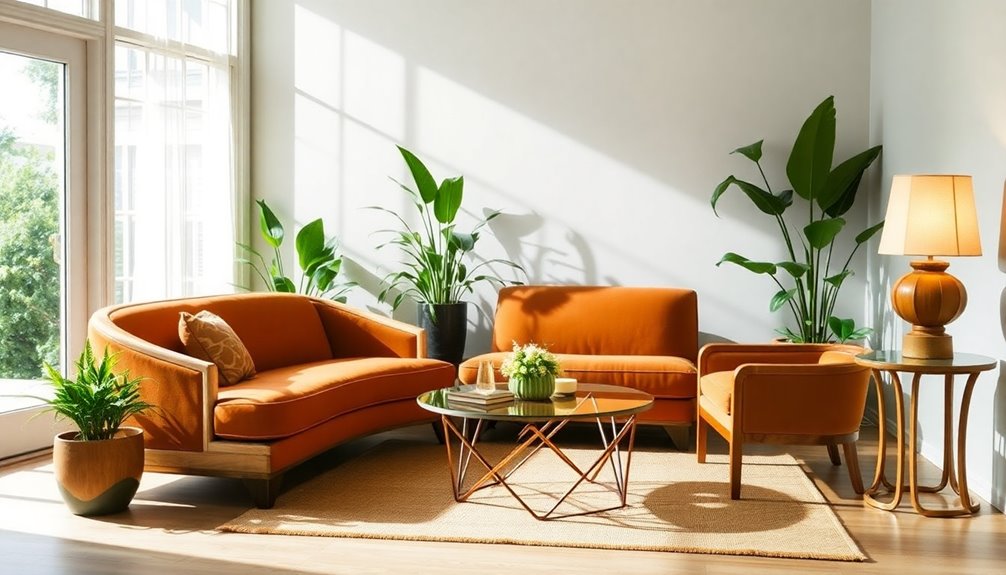
Choosing sustainable Art Deco furniture not only enhances your space but also offers significant environmental benefits. By opting for pieces made from renewable resources like bamboo, you support materials that grow quickly without harmful pesticides or fertilizers. Additionally, using reclaimed wood significantly reduces the demand for new lumber, helping to protect our forests. You'll also find that many sustainable options incorporate recycled materials, which cuts down on waste and the carbon footprint of producing new items. Moreover, furniture made from low VOC materials ensures better indoor air quality, minimizing harmful emissions within your home. Sustainable furniture is built to last, meaning you won't need to replace it frequently, which helps reduce waste. With proven durability, reclaimed wood often outlasts newly harvested timber. Manufacturers also prioritize low-impact production processes, using energy-efficient methods that minimize waste generation and emissions. This commitment to sustainable materials not only benefits the planet but also enhances the aesthetic appeal of your home. Furthermore, sustainable choices often lead to mood enhancement in your living spaces, creating a more pleasant and inviting atmosphere.
Highlighting Bamboo and Reclaimed Wood
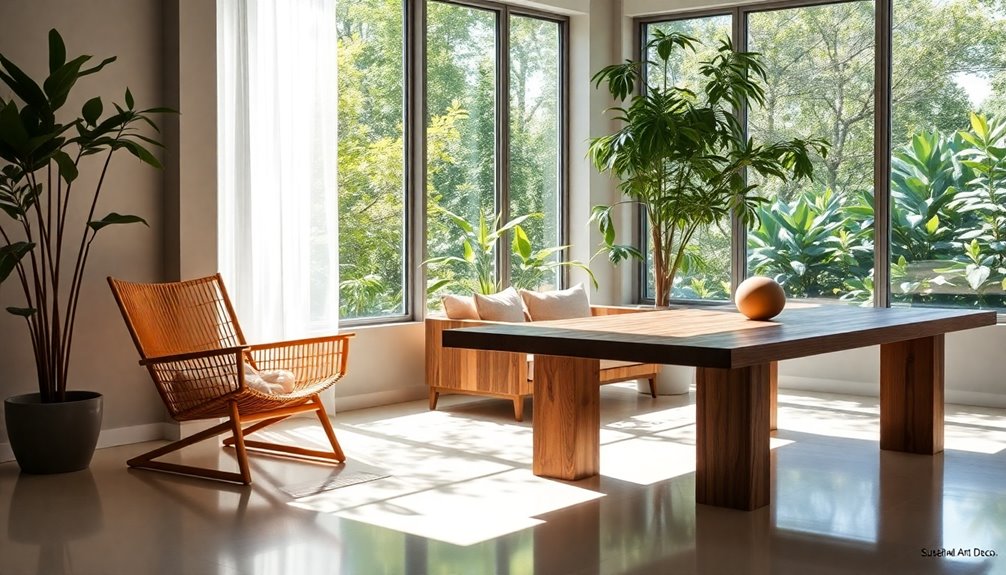
Bamboo and reclaimed wood are two standout materials that not only enhance the sustainability of Art Deco furniture but also bring a unique charm to your space. Bamboo's rapid growth—maturing in just three to five years—makes it a renewable resource that's perfect for eco-friendly furniture. Its durability allows for various styles, from elegant glass-topped coffee tables to striking peacock chairs. Plus, it fits seamlessly into modern and minimalist aesthetics, adding natural texture.
Reclaimed wood complements bamboo beautifully, creating unique, stylish pieces that minimize new timber demand. This approach not only prevents old wood from ending up in landfills but often results in high-quality, handcrafted furniture that reflects mid-century craftsmanship. As a result, choosing pre-owned furniture not only promotes sustainability but also adds character and history to your home.
By combining bamboo with reclaimed wood, glass, and metal, you can achieve a balanced aesthetic that showcases both materials' beauty. Regular maintenance is simple; just dust and clean with a mild detergent, and occasionally apply natural oil for a polished look.
Innovative Upcycling Techniques
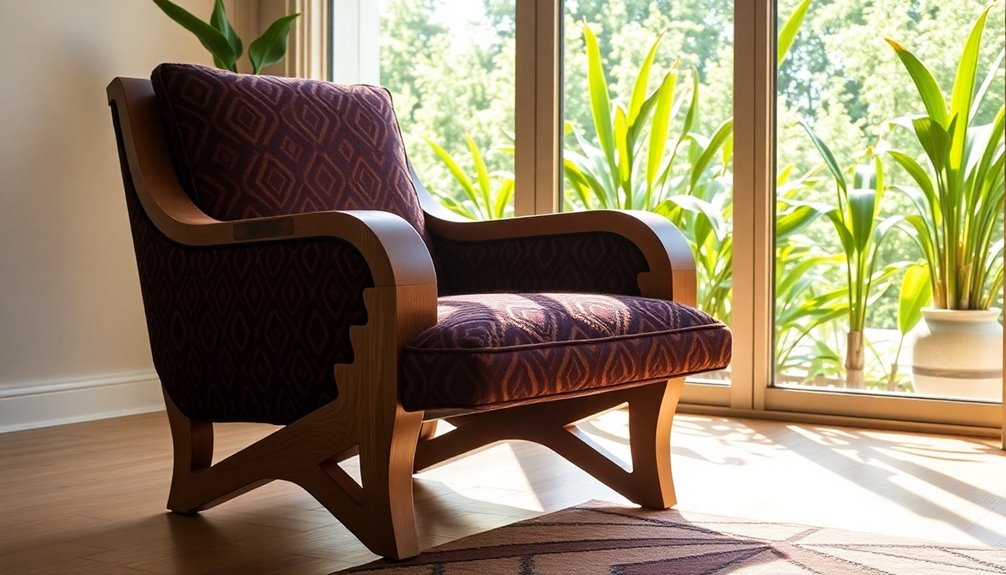
Embracing innovative upcycling techniques can transform vintage Art Deco furniture into stunning, eco-friendly pieces that reflect your personal style.
Start by stripping and preparing the surface; use a varnish stripper to remove old paint or varnish, then smooth it out with a mouse sander and progressively finer sandpaper, from 80 to 400 grit. Clean the surface with a mixture of Dawn dish soap and hot water, and always test for lead safety before diving in. Upcycling benefits include reducing waste and promoting sustainability, which further enhances the value of your project.
Next, focus on repairing and restoring hardware. A simple ketchup and vinegar solution can revive old metal fittings. After marinating, clean them with wire wool and apply a primer followed by metallic paint, sealing with a protective topcoat to ensure longevity.
For a bold look, consider painting and decoupaging. Use 2-3 coats of your chosen paint, drying between applications, and create geometric designs with masking tape. Incorporate durable papers for decoupage, sealing everything with a layer of Mod Podge for added protection.
Supporting Local Artisans
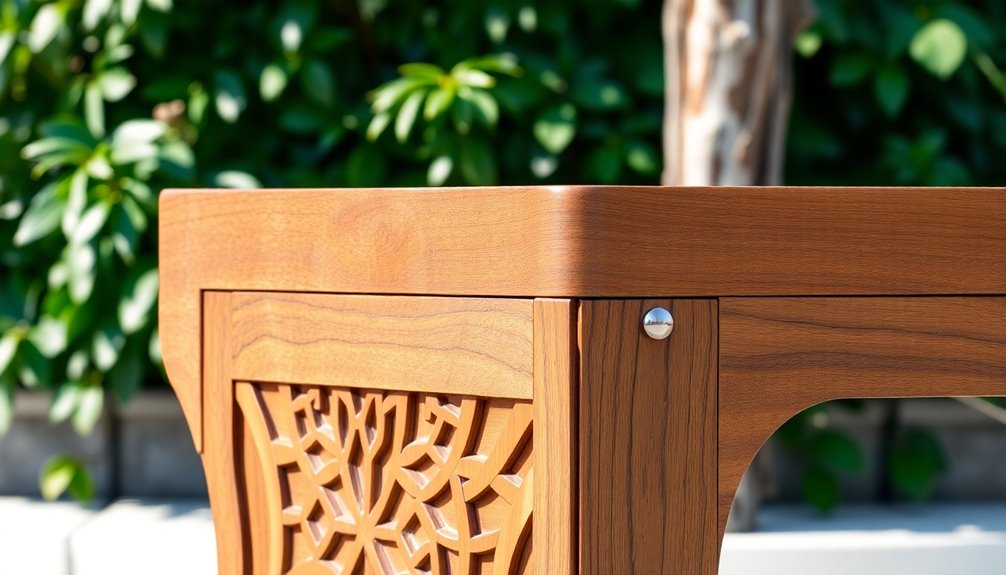
Supporting local artisans is often a rewarding choice that benefits both your home and community. When you purchase furniture crafted by local artisans, you contribute to the local economy by generating income and creating jobs. This helps keep money within your community, promoting economic growth and stability.
Plus, many artisans reinvest their earnings back into the area, enhancing overall economic health.
Local artisans also preserve traditional craftsmanship and skills that might otherwise fade away. Their specialized techniques ensure the continuation of high-quality, handcrafted Art Deco furniture with glossy finishes, integrating cultural heritage into modern designs.
By supporting these artisans, you help pass down valuable skills through apprenticeships and workshops.
Environmentally, local artisans tend to have a lower carbon footprint, thanks to reduced transportation needs and the use of locally sourced materials. This not only minimizes waste but also supports responsible resource management.
On a social level, choosing local artisans aligns with social responsibility, as it promotes ethical working conditions and fair wages. You can engage directly with these artisans, ensuring transparency and fostering a sense of community.
Supporting local artisans enriches your home while nurturing the fabric of your community.
The Future of Sustainable Furniture
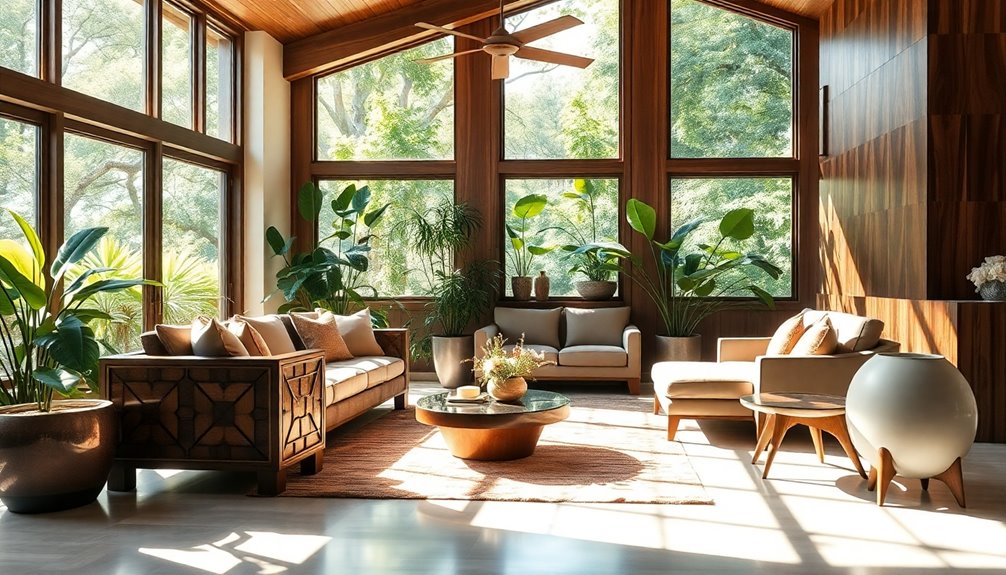
As consumers increasingly prioritize sustainability, the future of furniture design is shifting towards eco-friendly practices and innovative solutions.
You'll notice a growing reliance on sustainable materials like reclaimed wood, bamboo, and recycled metals, which not only reduce waste but also enhance aesthetic appeal. FSC-certified wood and organic fabrics ensure ethical sourcing, while materials that are easily recyclable or biodegradable promise a lower environmental impact at the end of their lifecycle. Additionally, the demand for eco-friendly materials like bamboo and reclaimed wood is driving designers to create pieces that are both sustainable and stylish.
Multi-functional and modular designs are also gaining traction.
Imagine sofas that can be reconfigured or desks that transform into dining tables to suit your needs. Storage options that double as seating or display areas maximize utility in your living space.
Technology is revolutionizing furniture as well.
Smart furniture equipped with sensor technology, wireless charging, and health monitoring systems integrates seamlessly into your modern lifestyle. It's all about blending functionality with design.
Frequently Asked Questions
What Are the Costs of Sustainable Art Deco Furniture?
When considering sustainable furniture, you'll notice higher initial costs due to quality materials and craftsmanship. However, long-term savings from durability and reduced replacements often make it a wise investment for your home.
How Can I Identify Authentic Vintage Art Deco Pieces?
To identify authentic vintage Art Deco pieces, check for a designer's mark, verify the production date, and examine the condition. Look for original parts and intricate detailing that showcase the craftsmanship typical of the era.
Are There Specific Care Instructions for Eco-Friendly Furniture?
Yes, you should use gentle, eco-friendly cleaners, avoid abrasives, and regularly dust. For wood, apply natural waxes for shine and protection. Keep furniture away from direct sunlight and heat sources to maintain its condition.
What Styles Complement Sustainable Art Deco Furniture in Home Decor?
To complement sustainable Art Deco furniture, consider incorporating Modern Minimalism for clean lines, Mid-Century Modern for sleek shapes, or Hollywood Regency for bold glamour. These styles enhance your space while maintaining a cohesive, stylish look. Additionally, when working with smaller areas, apply small space art deco tips such as using mirrored surfaces to create an illusion of depth and brightness. Opt for multifunctional furniture that reflects the elegance of the Art Deco era while serving practical needs. By thoughtfully blending these design elements, you can achieve a harmonious and inviting atmosphere in any room.
Can Sustainable Art Deco Furniture Be Customized for Unique Spaces?
Yes, you can customize sustainable Art Deco furniture to fit your unique spaces. By using advanced technology and sustainable materials, you'll create pieces that reflect your style while minimizing environmental impact.
Conclusion
Incorporating sustainable Art Deco furniture into your home not only enhances its aesthetic appeal but also supports eco-friendly practices. By choosing pieces made from bamboo, reclaimed wood, or upcycled materials, you're making a positive impact on the environment. Plus, when you support local artisans, you contribute to your community's economy. Embracing these eco-conscious choices today sets the stage for a brighter, more sustainable future in furniture design. Your home can truly reflect your values while looking stunning!
